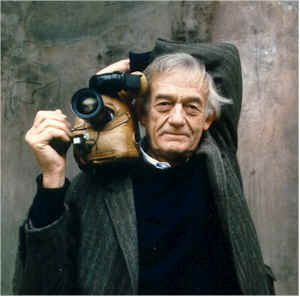
Leacock circa 1982
Richard Leacock Essays Leacock Project (draft)
|
|
|
|
Leacock circa 1982 |
|
Born in London, July 18 1921, Leacock grew up on his father's banana plantation in the Canary Islands till shipped off to boarding schools in England at the age of eight. He had no way of telling his schoolmates what it was like to live in the Canary Islands.
He took up photography with a glass plate camera, built a darkroom, developed his pictures but was not satisfied. At age 11 he was shown a silent film "TURKSIB" about the building of the Tran Siberian Railway. He was stunned, and said to himself "All I need is a cine-camera and I can make a film that shows you what it is like to be there".
Aged 14, he made CANARY BANANAS (10 min. 16mm, silent) scripted, directed, filmed and edited by him. It tells you all you need to know about growing bananas but did not, in his opinion, give you "the feeling of being there".
He spent the rest of his life trying to achieve this goal
Having filmed in the Canary Islands and then in the Galapagos Islands, (1938-9)
for ornithologist David Lack's expedition, he moved to the USA and majored
in Physics at Harvard in order to master the technology of filmmaking. Meanwhile
he worked as cameraman and assistant editor on other peoples films, notably
TO HEAR YOUR BANJO PLAY 1941, filming a folk music festival atop a mountain
in south Virginia where there was no electricity, with a 35mm studio camera
and 35mm film sound recorder, a rare achievement at that time. Three years
as a combat Photographer in Burma and China followed by 14 months as Cameraman
on Robert Flaherty's LOUISIANA STORY, an extraordinary experience of immense
value to his future work.
Many relatively conventional jobs followed, till 1954.
He was then asked to make a reportage on a traveling tent theater in Missouri:
the first film that he wrote, directed, photographed and edited himself, since
Canary Bananas.
This film, TOBY AND THE TALL CORN, went on the cultural TV program, OMNIBUS, in prime time and brought him into contact with Robert Drew, an editor at Life Magazine in search for a less verbal approach television reportage. Another stranger, Roger Tilton wanted to film an evening of people dancing to Dixieland music spontaneously. Leacock filmed JAZZ DANCE for him, using hand held combat techniques. It resulted in a superbly edited film that really did give you the feeling of being there, and still does.
But you could not film dialogue this way.
The search for high quality, mobile, synchronous equipment to facilitate observation was on. It took time, money ,and physics to solve the problems. By 1960 this was achieved and resulted in Robert Drew's film PRIMARY, an intimate observation of a primary election with JFK and Hubert Humphrey in Wisconsin. A new way of making films that did, indeed, give you the feeling of being there. Including synchronous dialogue.
An avalanche followed of wonderful films, made with Drew, Pennebaker, Maysles et al. But the US networks were not impressed, whereas in France at the CINEMATHEQUE FRANCAISE when Drew and Leacock screened PRIMARY and ON THE POLE, Henri Langlois introduced the films as "perhaps the most important documentaries since the brothers Lumiere"!
After the screening, a monk in robes came up to them and said, "You have invented a new form. Now you must invent a new grammar!"
When Drew went to work for ABC TV, "Leacock Pennebaker" was formed and produced HAPPY MOTHER'S DAY, DON'T LOOK BACK, MONTEREY POP, A STRAVINSKY PORTRATI and many others ending with the remnants of Jean Luc Godard's 1-AM. --- 1-PM.
In 1968 he was invited to join Ed Pincus creating a new film school at MIT. Small but geared to their ways of working. Since 16mm filming was becoming so expensive they developed super-8 film synch equipment with modified mass-produced cameras that were much cheaper. It worked but was not really satisfactory.
Many excellent filmmakers emerged including Ross McElway (SHERMAN'S MARCH), among others.
1989, retirement and a move to Paris where he met Valerie Lalonde and, together, they made LES OEUFS A LA COQUE DE RICHARD LEACOCK, (84 minutes) the first major film shot with a tiny Video-8 Handycam to go on prime-time television in France.
A combination of talent and love that continues into the digital age with both of them making films of their own choice without the pressures of TV producers, films that finally do give you "the feeling of being there".